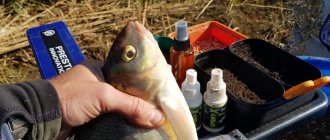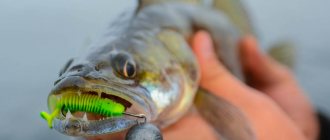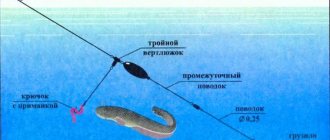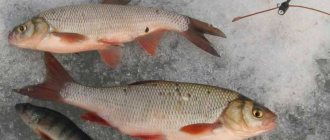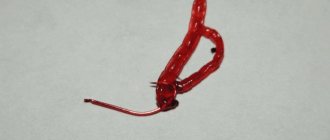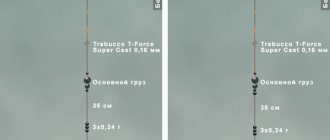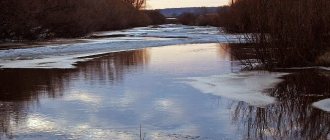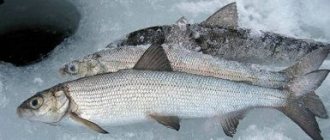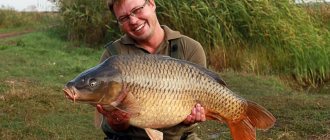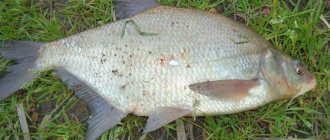Selection of fishing spots
Basically, these places are the same ones where all other fish were caught in the summer. These include runs with a constant flow near the exit from various pits. Here the fish love to gather in search of food, which allows them to be caught in large quantities. The bottom here mainly has a complex terrain, which the fish like so much. Significant catches are obtained in places where jets of water hitting the protruding shore form standing water with a slight backward flow.
Old tributaries of rivers perform well, as they warm up better in the sun and are shallow, so abundant growth of aquatic insects, which bream loves, prevails here.
On lakes, finding places with a good catch is quite difficult. It is worth looking for places overgrown with reeds and small shallows with a depth of no more than 2 meters. On large lakes it is worth looking for differences in depth, edges, and banks. It is recommended to fish in such places.
Catching bream in August on a feeder
Feeder fishing in August for bream.
Greetings to all fishing lovers. Fishing with a feeder is a very interesting and exciting activity. That feeling when you pull out a huge fish gives you great pleasure. Feeder fishing consists of two parts: fishing on the river and on the lake. This knowledge is given for use on the river. Choose a fishing rod; for a feeder, take into account the size of the river and the speed of water movement. Small reservoirs up to 100 m, a feeder up to 3 m long is enough, and if longer, choose one with a longer length, it can even be 3.9 m or more.
Select the feeder rod test based on the current speed. When fishing in strong currents, the feeder weighs from 100 grams. If the feeder is cast strongly, you need a powerful feeder with a lot of dough. When fishing in a weak current, a feeder weighing up to 80 grams is enough; if there is no current, a 50 gram feeder is enough. The choice of fishing line is made based on the choice of body of water. In the current, the priority will be the braided cord; it will sail the least, which reduces the possibility of the feeder being demolished. I think everything is clear with the gear. Now let's talk about how to catch.
The main difficulty when fishing with a feeder is choosing the place where you will fish.
It’s difficult to say where the bream will stand. Bream prefers depths of up to 5 meters, in all sorts of different holes. Bream also loves to live in places in the river where there is a reverse flow. You have chosen a place, feed the fishing spot. If the place is not far from the shore up to 15 meters, you can do without a feeder. Just roll about 8 small balls to make it easier for you to throw. If there is a bite, do not feed; when weakened, throw 2 pieces at a time and attract the fish. And a little about complementary feeding and complementary feeding.
Attract the fish with a thick consistency, this will prevent rapid erosion by the current. Therefore, add clay as needed; glue, which can be found in the store, will also work. Many fishermen make porridge themselves, from simple wheat, peas, millet, pearl barley, corn, worms, and maggots. If you prepare complementary foods correctly, they will be better even than store-bought ones. But there is a nuance, do not overdo it with different additives, and if you overdo it, you will simply repel the fish. My choice fell on store-bought bait for fishing, since I simply don’t have time to cook, and the price is reasonable.
The difference between bait for fishing
It is not so dense, and is washed out well by the current. You can fish with almost any bait, but I recommend a mixture of maggots and corn or peas and corn. It’s also good to catch with large worms, but sometimes the fry are bitten or the fish are simply not big. Installation of a feeder for fishing on a river is carried out using a loop, I won’t talk about this, because almost all fishermen know this. The line on the leash varies depending on the weight of the fish. Basically this is fishing line from 0.12 and above. Hooks for bream are suitable from number 10 and above.
The leash depends on the strength of the bream. When the bite is bad, it should be at least 70 cm, and sometimes more. When the bite is good and consistently bites even 30 cm. Make a choice based on the activity of the bream. Large bream bite mostly carefully, with wariness. I don’t recommend hooking him right away, you should wait until he swallows better, and this is easy to see at the end of the rod, he will tug strongly.
A medium-sized hook is sufficient. Bream fish is not particularly strong, but, nevertheless, wait, do not pull too hard. He will get tired quickly and there will be minimal resistance, carefully catch him in a cage, or you can take the fish under the gills. I think this will be enough for successful fishing on the feeder. Now let's talk about lakes.
Fishing on the feeder, lake -
I want to say right away that there are obvious differences in catching bream on rivers and lakes, it’s important to differentiate. Choose a fishing rod for a lake, and the lake is still water. In general, a feeder for a lake is almost no different from a feeder for fishing on rivers. The choice also depends on the size of the lake, but choose smaller feeders, as they are not suitable for the river. Select the weight of the feeder for still water based on the fishing distance. Everything is very simple here, the further you have to throw, the heavier the feeder should be. And the choice of test depends on the feeder itself. Basically this is a feeder with a dough of 30-70g, and heavy feeders for fishing on the lake are very rare. The only exception may be a large lake with great depth.
When fishing on lakes, choose a much softer tip, there will be a more accurate touch with careful bream. To communicate with the fish, I recommend, as well as for the current, a braided fishing line; it makes it possible to feel the tackle more and make a more effective cast to the fishing spot. I think about this, that's enough. But how do you catch it? Choose a place for fishing. The situation with the lake is more difficult. Bream is a fan of pits, try to throw them into the entrance to the pit. Also a fan of standing in the reeds.
But there is a nuance, this is that the algae that stretch from the bottom will interfere with fishing. The main thing in feeder fishing is to attract fish. Usually, during a current, a bream can rise from the bottom and catch the smell of complementary food that comes with the current. When fishing for bream with a feeder in still water, prepare the complementary food very carefully, this is very important here, this is not a current.
Feed the bream well, 5-7 kg of various cereals and various mixtures. The difference between lake and river complementary foods is in consistency. Make bait for the lake so that it crumbles, because there is no current and it will not wash away. Strong, dense bait will lie like a stone, but bream are not interested in this.
You can also feed with a feeder with large dough and using a feeder. I recommend using a cone-shaped feeder; it contains about 180 grams. bait, when it falls to the bottom it will immediately open. Just give it a quick tug and it will be empty. Throw in the place where you will fish, do not throw in different directions. Make yourself a target on the other side and secure the fishing line with a clip. And then throw it in the same place. When you have already fed thoroughly, wait 30-50 minutes, the fish will approach the food.
At this time, prepare gear and other things for fishing. The fishing line is basically the same on rivers, but I advise you to use a thinner leash, bream on the lake is very careful, this is not a river bream. You can increase the leash, the water is still, it will not be possible to get confused, this will be better, since you will not be constantly tracking the leash. You can catch bream on the lake and on the river using the same baits.
Let me remind you that these are peas, maggots, worms, corn, this also justifies itself, you can use a large black leech, just be sure to cut off the suckers. Throw the feeder in the place where you threw the food, do not compact the food into the feeder tightly, this will make it difficult for the aroma to spread throughout the lake, this will complicate the fishing process.
Lake bream bites accurately, unlike river bream. I advise you not to rush to hook. The bream takes a closer look, tries it, you will see this by its smooth and light twitching on the rod. Then there will be more confident twitching, the tip of the rod will bend down, feel free to hook. Let me remind you of what I said earlier, DON’T HIT IT TOO HARD. Take it out quietly, slowly, as the fishing line is thin and may break. Here you need to drag smoothly, soften the jerks of the fish, otherwise the line may break. Bream is not a hardy fish, in less than a minute you will be drawn to your tank.
Fishing time.
If everything is clear about the fishing location, then don’t fish early. As for me, it is best to come fishing 3 hours before sunset, this is necessary in order to get used to the shore, prepare it for yourself, choose a place that is convenient for you in the dark. Double-check the bottom topography; this can be done using a small sinker weighing about 25-35 grams. Once everything is ready, start mixing food and prepare your gear. Always remember, when you fish on a feeder, it means you are actively fishing; when you cast the rod, don’t wait too long for a bite.
Choosing the time to catch bream
In August, usually early morning and late evening are the best fishing periods, however, this is not always the case. It happens that at 25 degrees during lunch hours active bites of large bream just begin. The time for such a bite starts from 10 to 16 o'clock in the afternoon. When the day comes to an end, it is the turn of active evening bream fishing, which can last until dawn. The best time for such fishing is the period from sunset to 1 am, then a slight decline and resumption closer to dawn.
Fishing for bream in August on a feeder
Bream is the main synonym for feeder fishing, because it is for catching this fish that the latest techniques and tactics for feeding places, devices and a huge amount of gear have been developed.
It is in August, when the nights become longer and the water temperature constantly changes, that the time comes to catch large individuals of this species.
In the last month of summer, an amazing time begins - fish flock together and feed intensively, and the process takes place in classic places with shallow depths, which gives every fisherman a great chance to catch the fish he dreamed of.
Selection of tackle for bream
Since bream is a fairly strong fish, it is recommended to select a long rod, from 3 to 4 meters. Casting such fishing rods is easier and much more accurate. The test should not exceed 120 grams. The reel is chosen based on every taste; the only thing that should not be done is to use reels smaller than 4000. Due to the small size of the gears, the mechanism wears out quickly.
When choosing a fishing line, focus on the casting distance. If it is 25 meters, then it is recommended to use a fishing line; at longer distances it is better to use a braided cord of a smaller diameter.
Leashes are also selected depending on the bites. When there are practically no bites, the length of the leash is reduced, and when, on the contrary, it often bites, but the fish cannot be pulled out, the length of the leash is increased.
Secrets of success: how to catch bream in August
Such bream can be smoked.
Photo: Andrey Yanshevsky. Very often, fishing in the summer is combined with a family vacation, for which the shore of a large lake or reservoir is preferable. It is important to choose the desired fishing option, depending on the behavior of the bream in a particular body of water.
First of all, you need to try to understand what now constitutes the basis of food for fish.
For example, in a shallow, heavily overgrown lake, the main food for this fish is worms and snails. In a reservoir without developed coastal vegetation, bream feed on zebra mussels, young shoots of uruti and bloodworms.
In a small river it eats caddis flies, bloodworms and worms. In large and full-flowing, that is, deep rivers, bream no longer refuses fingerlings, as well as worms and other food of animal origin. But he does not disdain food of plant origin, provided it is easily digestible.
Therefore, fishing in the hot season is varied, interesting and exciting, but at the same time difficult and careful.
Very interesting are flowing lakes with well-developed coastal vegetation, in which the average depth is one and a half to two meters, and in the holes - four to five. It is these reservoirs that are most favorable for the reproduction and growth of large bream. It combines an optimal food supply with good conditions for spawning.
Promising places for fishing here are very diverse. A good section of the coastal zone is where the bottom slopes gently from the very shore. If the bottom is not clayey, then almost all of it becomes overgrown. Bream comes here by chance in August.
Another characteristic part of any lake is the deepest part. The hole can be either near the shore or somewhere near the riverbed. The top edge of the pit is the most promising place. The only thing that complicates matters is that it is not always possible to fish here without a boat. But large bream feel the boat very well. You have to use match tackle for long casting or a feeder.
Between the coastal “vegetation” zone and the pit there is an “irrigation”. It is possible to find bream here at certain times of the day, but only if you can find feeding areas. Such places are almost always areas “rich” with bloodworms, zebra mussels or caddisflies. To find such a place, it makes sense to “tap” the bottom with a depth gauge or echo sounder. As a last resort, you can dive.
I should note that if you are really hunting for bream, then it is better to fish from the shore, at dawn, and even better at night, when the fish is approaching the shore.
| At dawn, the bream approaches the very shore. Photo: Andrey Yanshevsky. |
There is more choice of places on the reservoir, but there is also decent pressure from fishermen and vacationers. It’s definitely better to fish here at night. Good places are channel edges that come close to the shore. So close that you can fish with a long fly rod or pole. The fishing depth can be only 2-3 m, but more often bream prefers depths of about 4 meters.
Another good location might be a shallow water or shallow watering area with zebra mussels. Then you will need a feeder.
In any case, in order to tie the fish to the fishing spot, you will need a decent amount of high-quality bait. It is necessary to add components of animal origin to the bait. Maggot in “bream” bait almost always dramatically increases the effectiveness of its action. The total volume of maggots per 5-10 kg of bait can be 0.5 liters.
Fishing with traditional fly fishing gear has the undoubted advantage that the casting range of the equipment with an 11-meter rod will be greater than that of any plug. The disadvantages include the fact that the fly rod does not allow you to absolutely accurately deliver and hold the bait at the fishing point. This is impossible because there are no landmarks at night.
Using a plug rod allows you to get rid of all technical problems. I personally take a float with a thick antenna, and through a silicone adapter tube I put a “firefly” on it. It’s even better if the float is designed specifically for replaceable antennas with a diameter of 3-4 mm.
Despite the fact that bream bites more accurately at night than during daylight hours, it is still preferable to use bloodworms, caddis flies, small dung worms or a “bow” made of bread as bait on the hook. Of the vegetable baits, I would put bread and pearl barley in first place.
The fishing technique does not contain anything unusual, except that the bait can be played effectively. To do this, after the bait has reached the groundbait at the bottom, a pause is made. After a pause, by moving the rod upward, you pull the bait towards you a few centimeters, and then by lowering the tip of the rod, you let the equipment fall freely.
To create an effective and natural game, you will have to increase the length of the leash to half a meter, or even more. If during fishing, especially at dawn, there is disturbance in the water, then the most effective thing can be to hold the anchored equipment in place. You just need to make sure that the bait does not fall into the ground.
Fishing in the shallow water zone is good even during the day, but only if there is a good surf and several meters of water from the shore are stirred up with silt or clay. Bream visits such places at any time of the day. In the surf it is better to fish with a worm lying on the bottom. I advise you to choose a fishing spot in the middle of a strip of muddy water with a depth of 1-1.5 m, near flooded trees and away from coastal vegetation.
With the onset of the fog season, bream visits shallow places less and less, moves to the depths and comes to the shore at very specific times and in certain places. As the water cools towards the end of the month, bream fishing in small and medium-sized, but deep lakes and quarries becomes productive. It's easier to spot here.
As the temperature drops, microscopic algae gradually die off and the water becomes clear. Aquatic plants stop growing young shoots. With a further decrease in water temperature, the plants acquire a brown color and begin to sink to the bottom. As plants begin to die, the crustaceans, worms, larvae and mollusks that inhabit them leave the plants and burrow into the ground or move to deeper places.
As the water gets colder, the fish continue to feed in deeper places. The best hours for biting are also changing. The colder the water, the more often the peak of the bite occurs in the afternoon hours.
There is a fairly rough pattern. In spring, when the water is cold, it is better to look for fish in shallow places when the sun warms up. In summer, biting hours shift towards night. With the autumn cooling of the water, it is more profitable to catch fish when the sun warms up, but at depth or at the border of vegetation.
It becomes very important to adapt to fishing with minimal weight equipment. As practice shows, usually for fishing from a depth of four meters at the end of August it is enough to use equipment with a total weight of no more than one gram. If a strong side wind blows, then you have to use slightly heavier equipment. This is due only to the windage of the fishing line.
The design of the equipment, regardless of the fishing method, must be complex, that is, with a distributed load.
As the water gets colder, it is necessary to make adjustments to the composition of the bait, reducing the amount of flavorings and increasing the proportion of the animal component. Color becomes important. The bait can be easily darkened by adding soil or peat to it. If the soil in the reservoir is sandy, then peat should be discarded.
Approximately half of the amount of bait is immediately transferred into small balls and you need to throw them as accurately and as closely as possible at the selected fishing point. After this there is some waiting period. As long as there are bites, there is no need to feed additionally. But the bites stopped or became more cautious. Usually there are three reasons.
The first is that the fish does not have enough tasty component in the bait, then it needs to be supplemented. Secondly, you may literally run out of fish. The third reason is the weather change. Then feeding is useless. You need to be patient and wait for the moment when the bite is restored.
Andrey Yanshevsky August 18, 2021 at 05:32 pm
Bait for bream in August
It is recommended to select food with large elements in large quantities and throw it exactly at the places of future fishing. This bait is based on a ready-made mixture, sold in stores, which fishermen improve for specific bream fishing conditions. For large specimens, bait is selected, consisting of all kinds of grains. Lightly roasted flaxseeds have worked well; you can also use chopped worms or bloodworms with maggots as an additive.
At the same time, do not forget to add all kinds of aromatic additives to the mixture, such as “tutti-frutti” sold in fishing stores, drops of anise, regular vanilla or honey. Garlic and dill are also a good option. It is always advisable to experiment to find the best option for a particular bream fishing location.
What is bream most likely to bite on in August?
- The worm is one of the most versatile and easily accessible baits, but it is often the one that allows you to catch large bream. By stringing it with loops, it forms a very appetizing moving bunch, which is what attracts the attention of bream, as well as other large fish. However, when small fish are actively biting, the worm loses its “marketable” appearance, and the chances of catching a trophy become somewhat lower.
- The maggot is extremely active, so much so that it can sometimes be difficult to get it onto the hook. Several maggots are placed on a hook at a time, usually from 3 to 6 pieces on a medium hook. Unlike a worm, a maggot is more resilient on the hook and creates greater vibrations, thereby stimulating the fish’s appetite. Maggot has a thicker skin, which allows it to survive after “idle” bites from small fish.
- Artificial and vegetable baits are most effective at the end of summer, since this is the time when the crops ripen and at this time the fish are accustomed to feeding on them. Balls of dough or mastyrki, with thread inside, are very effective when fishing in the current as they do not wash off the hook.
Instead of thread, you can also use special hooks with a spring around the forend. If you fish on a reservoir with a muddy bottom, then it is very useful to use polystyrene foam. In addition to lifting the bait, it is a good bait for bream and other bottom fish. - Mastyrka.
To prepare mastyrka you need brand, peas and honey:
- Soak the peas in cold water for 12 hours. This is necessary in order to reduce the cooking time of the peas.
- Fill the pan with cold water and add the soaked peas to it. Cook the peas until they are completely swollen (about 2 hours).
- Drain the cooked peas.
- Puree the peas through a fine sieve or meat grinder until a thick porridge forms.
- Add a teaspoon of honey to the resulting mixture to attract larger individuals.
- To get the desired consistency, gradually add semolina, constantly kneading it.
- Wrap the finished mastyrka in a damp cloth.
Secrets of catching bream with lard
Recently, most professional bream fishermen use lard as a bait. Indeed, large bream are more willing to take lard, and at the same time lard is a very convenient bait, it holds firmly on the hook, does not fly off when casting and has a pleasant smell for the fish.
It is best to use fresh, not salted or frozen lard.
You should choose a layer of fat that is closer to the skin and has many veins.
Before traveling, cut it into sized pieces and put it in the freezer.
During the fishing process, part of the lard is kept wrapped in paper or a rag, and a few pieces are placed nearby so that they melt a little.
If possible, it is advisable to dig a hole, lightly moisten it with water and store it there. This way you can avoid spoilage and changes in the smell of lard.
To increase the effectiveness of this bait, the lard can be painted in colors that are attractive to bream. But the greatest benefit comes from the combined use of lard and moving animal baits.
Lard has a specific smell, attracting fish from afar, and the maggot or worm, with its movements, draws attention to the hook.
Bait selection
When it comes to bait for catching bream in August, anglers always take with them a standard set of worms, bloodworms and maggots. In addition to them, it is recommended to use canned corn, boiled pearl barley porridge, and the famous flour mash, either made from flour or semolina. In places with a large current and the presence of shipping, wheat, steamed to the desired softness, and green peas performed well.
Of course, it’s impossible to take into account all the subtleties, so try, search and be sure to share your observations.
Choosing a fishing spot for catching bream in August
Promising places are straight river runs, where a smooth current prevails and which are formed at the exit from the pits.
In general, such places are a real paradise for fishing, because a huge amount of fish accumulates in them, not only bream, but also other representatives.
In such places, the bottom is characterized by a broken topography with complex jets, which is especially to the taste of fish.
Effective catches can also be found in still waters with little rip current. In such places, a fairly large depth is formed and many large individuals are always present.
Also a good place for fishing are the oxbow lakes adjacent to the river. In most cases, such reservoirs are not deep and therefore warm up well, due to which there is a large growth of microorganisms in them, which is what the fish feed on.
If we talk about lake fishing, it should be noted that finding a place in a lake where a large number of fish accumulates is very problematic, with the exception of cases of coastal fishing.
Selection of gear for catching bream in August
Large bream is a fairly lively fish, which affects the choice of gear. When choosing, it is important to pay attention to the performance characteristics of gear, because if you do not show due attention and responsibility, fishing may not end up looking promising.
So, for example, when starting to choose a fishing rod, you need to choose models that reach a length of about 3.6-3.9 meters.
With such rods it is much more convenient and freer to make long casts, especially at night, when visibility conditions for the object are significantly deteriorated.
The choice of reel depends on the preferences of the fisherman; it is only worth noting that the most advisable is to buy a reel whose size is at least 4000.
A difficult choice must be made between buying a braided cord or a regular fishing line.
So, for fishing at a distance of up to 25 meters, a regular fishing line is suitable, since its excessive stretchability will not have a negative impact on the fishing process.
If you plan to fish at a distance of more than 25 meters, then it is best to give preference to a braided cord, but the diameter should be chosen as small as possible.
The length of the leash also plays an important role, so you need to choose it carefully and thoughtfully.
Features of behavior
Bream is a bottom-dwelling fish and prefers to stay close to the bottom most of its life. It also avoids places with fast currents, so fishing for bream in August is better in calm areas of a reservoir or river. Bream can be found in bays, at river bends, where it is more or less calm and there is depth. With the arrival of twilight or in inclement weather, the bream comes closer to the shore, so a float rod will be very useful here. And with dawn, it again rushes into the depths.
When choosing a place, you should take into account that this fish does not like a sandy bottom; the best bream fishing in August is in areas where the bottom is clayey and slightly silted. If you feed well, the fish will also fit in places where rocks predominate on the bottom.
If we combine everything, we can identify characteristic places where bream fishing in August is the best: a clayey shore, where the depth gradually increases; a steep bank, where a few meters is already quite deep; a gentle bank with a lot of aquatic vegetation, where the depth increases gradually; in this case, a long cast will be required.
